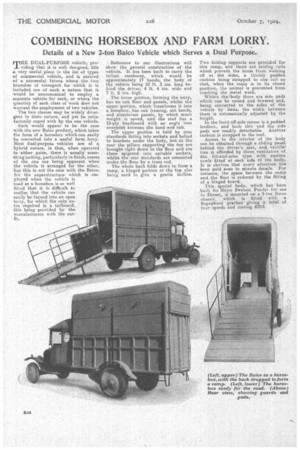COMBINING HORSEBOX AND FARM LORRY.
Page 18

If you've noticed an error in this article please click here to report it so we can fix it.
Details of a New 2-ton Baico Vehicle which Serves a Dual Purpose.
MHE DUAL-PURPOSE vehicle, pro
viding that it is well designed, fills a very useful place in the list of types of commercial vehicle, and is assured of a successful future where the two branches of transport for which it is included are of such a nature that it -would be uneconomical to employ a separate vehicle for each, or where the quantity of each class of work does not warrant the employment of two vehicles.
The two classes may be widely divergent in their nature, and yet be satisfactorily coped with by the one vehicle.
Such would appear to be the case with the new Baico product, which takes the form of a horsebox which can easily be converted into a useful farm lorry. Most dual-purpose vehicles are of a hybrid nature, in that, when operated in either guise, there is usually something lacking, particularly in finish, traces of the one use being apparent when the vehicle is arranged for the other, but this is not the case with the Baico. for the superstructure which is employed when the vehicle is used as a horsebox is so well fitted that it is difficult to realize that the vehicle can easily be turned into an open lorry, for which the only extra required is a tailboard, this being provided by the manufacturers with the outfit.
Reference to our illustrations will show the general construction of the vehicle. It has been built to carry the tallest racehorse, which would be approximately 17 hands, the body of the vehicle being 10 ft. 3 ins, long behind the driver' 4 ft. 4 ins, wide and 7 ft. 6 ins. high.
The lower portion, forming the lorry, has an oak floor and panels, whilst the upper portion, which transforms it into a horsebox, has oak framing, ash bends, and aluminium panels, by which Much weight is saved, and the roof has a 13-ply headboard with an angle iron overjoint between the head and cab.
The upper portion is held by iron standards fitting into sockets and bolted to brackets under the body, but at the rear the pillars supporting the top are brought right down to the floor and are there spigoted into suitable sockets, whilst the rear standards are connected under the floor by a truss rod.
The whole back folds down to form a ramp, a hinged portion, at the top also being used to give a gentle incline. Two folding supports are provided for this ramp, and there are folding rails which prevent the horse from walking off at the sides, a thickly padded cushion being' strapped to one rail so that, when the ramp is in its closed position, the animal is prevented from touching the metal work. Within the body there are side pads which can be raised and lowered and, being connected to the sides of the vehicle by links, the width between them is automatically adjusted by the height.
In the front off 'side corner is a padded feedbox, and both this and the side pads are readily detachable. Another cushion is strapped to the roof. Access to the interior of the body can be obtained through a sliding panel behind the driver's seat, and ventilation is afforded by three ventilators of the hit-and-miss type with suction cowls fitted at each side of the body. It is obvious that every attention has been paid even to minute details. For instance, the space between the ramp and .the floor is reduced by the fitting of a hinged board.
This special body, which has been built for Major. Denison Pender for use in Dorset, is mounted on a 2-ton Baico
chassis' which is fitted with • a Supaphord gearbox giving .A total of four speeds and costing £214.






























